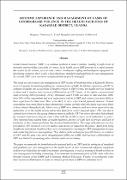| dc.contributor.author | Tumwebaze, Margaret | |
| dc.contributor.author | Bakaitwoha, Everd Maniple | |
| dc.contributor.author | McMorrow, Shannon | |
| dc.date.accessioned | 2019-11-04T07:53:02Z | |
| dc.date.available | 2019-11-04T07:53:02Z | |
| dc.date.issued | 2008-12-01 | |
| dc.identifier.citation | Tumwebaze, M., Bakaitwoha, E.M. and McMorrow, S. 2008. Lifetime experience and management of cases of gender-based violence in the health facilities of Kabarole district, Uganda. Health Policy and Development, 6(3), p.102-116. | en_US |
| dc.identifier.uri | http://hdl.handle.net/20.500.12280/2445 | |
| dc.description.abstract | Gender-based violence (GBV) is a common problem in many countries, leading to high levels of mortality and morbidity, especially of women. In the health sector, GBV presents in a cryptic manner due to fear by the victims, poor records, culture, inadequate staffing and inadequate equipment. In developing countries, there is also a lack of policies, standards and guidelines for case management. As a result, GBV cases are never recognized and are poorly managed.
This study set out to assess the management of GBV victims in health facilities of Kabarole District, western Uganda. It aimed at profiling the common forms of GBV, the lifetime experience of GBV by ordinary residents, the accessibility of health services to GBV victims, the health services rendered to them and to analyse inter-sectoral collaboration on GBV issues. A descriptive cross-sectional study involving 400 respondents, 40 key informants and 2 FGDs was done in May and June 2006. Over 96% of the respondents had ever experienced a form of GBV and women were more likely to have experienced it than men. Most were likely to have experienced physical violence. Female respondents were more likely to have abused their victims verbally while the males were more likely to have abused them physically. Most cases of GBV were domestic and were never reported to any authorities or to the health system unless they had led to severe physical injury. This was due to cultural restrictions on discussing domestic matters publicly. GBV survivors also often lacked funds for transport and processing the cases either with the health services, local authorities or police. They reported long waiting times at health facilities, absence of staff, lack of privacy and lack of medicines as the common problems they faced at health facilities. The range of health care services provided to GBV survivors was very narrow and mostly on request by the police. Apart from being insufficient and absent, health workers were not trained in screening for GBV, management of cases and conducting forensic investigations. They did not probe actively for possible history or evidence of GBV and the data were never disaggregated within the HMIS. Intersectoral collaboration on GBV was limited to preparing police dossiers and court testimony.
The paper recommends the formulation of a national policy on GBV, and the setting up of standards and guidelines for case management in the health sector. It also recommends adequate equipment of district level facilities for sufficient forensic investigations as well as training of health workers in case management including counseling. It recommends institutionalization of GBV data collection through revision of the HMIS and Continuing Medical Education. Finally, it recommends wider inter-sectoral collaboration in order to enhance prevention of GBV at community level | en_US |
| dc.language.iso | en | en_US |
| dc.publisher | Uganda Martyrs University Press | en_US |
| dc.relation.ispartofseries | Health Policy and Development;volume 6 number 3 | |
| dc.subject | Management of cases | en_US |
| dc.subject | Gender based violence | en_US |
| dc.subject | Health facilities | en_US |
| dc.title | Lifetime experience and management of cases of gender-based violence in the health facilities of Kabarole district, Uganda | en_US |
| dc.type | Article | en_US |


